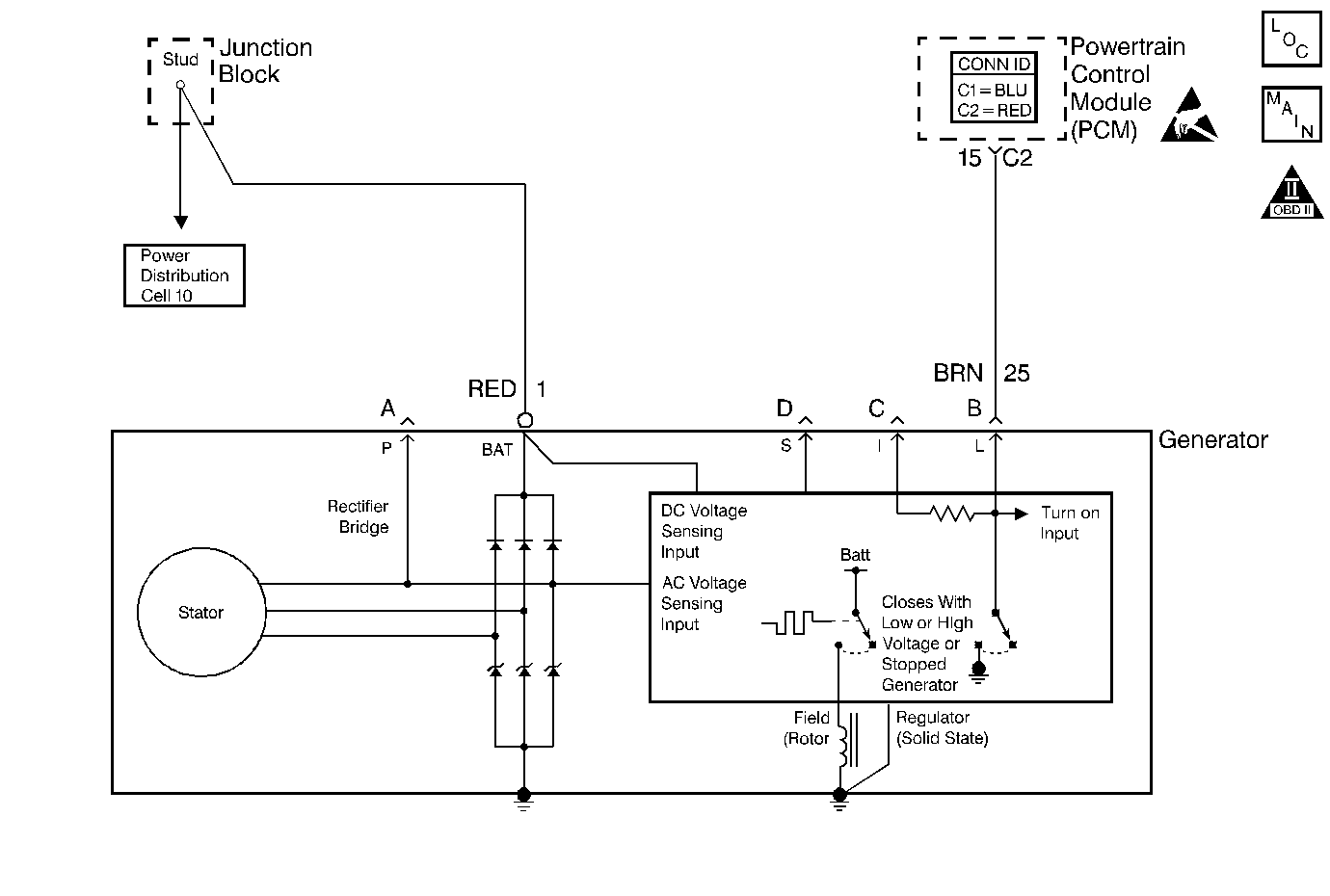
Circuit Description
The L-terminal circuit from the generator is a discrete circuit into the powertrain control module (PCM). The PCM supplies the ignition voltage to the generator lamp feed. This ignition voltage is pulled low by the generator once the ignition switch supplies ignition 1 voltage. The voltage stays low until the generator turns. When the generator is up and running, the PCM detects ignition voltage. Therefore, with no failures with the vehicles charging system, the lamp terminal circuit will go low 0 volts when the ignition switch is powered up and then goes to the ignition voltage after the engine is started.
When the charging system detects a fault such as a circuit shorted to ground , the instrument panel cluster (IPC) displays a message.
Conditions for Running the DTC
Engine operating
Conditions for Setting the DTC
The PCM detects an improper voltage on the generator L- terminal circuit.
Action Taken When the DTC Sets
| • | The powertrain control module (PCM) stores the DTC information into memory when the diagnostic runs and fails. |
| • | The malfunction indicator lamp (MIL) will not illuminate. |
| • | The PCM records the operating conditions at the time the diagnostic fails. The PCM stores this information in the Failure Records. |
Conditions for Clearing the DTC
| • | A last test failed, or current DTC, clears when the diagnostic runs and does not fail. |
| • | A history DTC will clear after 40 consecutive warm-up cycles, if no failures are reported by this or any other non-emission related diagnostic. |
| • | Use a scan tool in order to clear the DTC. |
Diagnostic Aids
Important: Remove any debris from the PCM connector surfaces before servicing the PCM. Inspect the PCM connector gaskets when diagnosing or replacing the PCM. Ensure that the gaskets are installed correctly. The gaskets prevent water intrusion into the PCM.
| • | The following may cause an intermittent: |
| - | Poor connections -- Check for adequate terminal tension. Refer to Testing for Intermittent Conditions and Poor Connections in Wiring Systems. |
| - | Corrosion |
| - | Mis-routed harness |
| - | Rubbed through wire insulation |
| - | Broken wire inside the insulation |
| • | For an intermittent, refer to Symptoms . |
| • | A generator fault, such as a shorted output diode, malfunctioning regulator, open or shorted rotor may cause a low battery charge. Refer to Diagnostic System Check - Engine Electrical in Engine Electrical for further information and generator diagnosis. |
| • | Use a scan tool in order to diagnosis the generator circuits. A scan tool displays Generator L-Terminal Inactive when there is a problem with the L-terminal circuit. |
Test Description
The numbers below refer to the step numbers on the Diagnostic Table.
Step | Action | Value(s) | Yes | No |
|---|---|---|---|---|
1 | Did you perform the Powertrain On-Board Diagnostic (OBD) System Check? | -- | ||
Does the scan tool display the generator L-terminal as Inactive? | -- | Go to Diagnostic Aids | ||
3 | Probe the generator battery feed circuit using the test lamp connected to ground. Refer to Measuring Voltage in Wiring Systems. Does the test lamp illuminate? | -- | Go to Diagnostic System Check - Engine Electrical in Engine Electrical. | |
4 |
Is the voltage the same as or more than the specified value? | 10 V | ||
5 |
Does the DMM indicate continuity? | -- | ||
6 | Test continuity from terminal B at the generator harness connector to battery ground using the DMM. Refer to Testing for Continuity in Wiring Systems . Does the DMM indicate continuity? | -- | ||
7 | Repair the short to ground in the generator circuit. Refer to Wiring Repairs in Wiring Systems . Is the repair complete? | -- | -- | |
8 | Repair the open or high resistance in the generator circuit. Refer to Wiring Repairs in Wiring Systems . Is the repair complete? | -- | -- | |
9 | Inspect the terminal contact tension at the PCM harness connector. Refer to Testing for Intermittent Conditions and Poor Connections in Wiring Systems . Did you find and correct the condition? | -- | ||
10 |
Important:: Program the replacement PCM. Replace the PCM. Refer to Powertrain Control Module Replacement . Is the action complete? | -- | -- | |
Did you find and correct the condition? | -- | |||
12 | Repair or replace the generator. Refer to Generator Replacement in Engine Electrical. Is the action complete? | -- | -- | |
13 |
Does the scan tool indicate that this test ran and passed? | -- | ||
14 | Select the Capture Info option and the Review Info option using the scan tool. Does the scan tool display any DTCs that you have not diagnosed? | -- | Go to the applicable DTC table | System OK |
